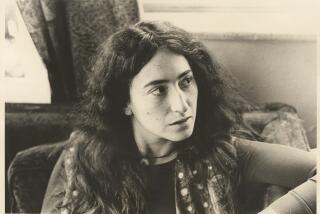Citizen Hurst
- Share via
Although she was one of the most famous, and certainly the most highly paid, of this century’s writers--celebrated, feted, interviewed and profiled--Fannie Hurst has long since ceased to be a household name. From the 1910s through the ‘40s, Hurst’s blend of sentimental realism and progressive social commentary seemed to dominate the American cultural scene, and her writing was as likely to appear in the pages of leading newspapers as she was in the conference rooms of the White House, where her friends the Roosevelts gave her an open invitation. Top publishers vied for anything with her name on it. Hollywood clamored for everything she wrote, whether love story, tale of immigrant struggle or vision of the sexual and domestic oppression of middle-class women. Journalists sought her opinion on everything from Zionism (which she opposed) to divorce laws more favorable to women (which she advocated). Today, Hurst may still be familiar through the surviving handful of the films adapted from her work (there have been 28), which are still shown on late-night and cable television: “Humoresque,” “Back Street,” “Young at Heart” and “Imitation of Life” (based on her most well-known and controversial novel of the same name). But those who want to read Hurst’s 18 novels will need to scour second-hand bookshops or look for scholarly editions.
This state of affairs challenges a biographer. Should one attempt to explain a sea change in literary and popular taste, maybe even try to argue one’s subject back into the canon? Or should one, instead, leave such accounting to the historians and literary critics and focus on the writer’s life? In her lively and engaging biography, Brooke Kroeger (whose previous book concerns the life of daredevil feminist reporter Nellie Bly) reconciles these options by offering a fascinating account of Hurst and her cultural moment, showing how literary reputations rise and fall and how they may be very deliberately built as well. Part of Kroeger’s project, as her subtitle “the talent for success” would suggest, is to demonstrate Hurst’s own self-fashioning. And though the person Kroeger presents to us proves difficult to like, Kroeger’s Hurst not only engages our attention as an interesting and famous woman at the center of the political and cultural life of her time but also provokes larger psychological and social questions. What comes across most sharply is both Hurst’s particular genius for managing her own success and her persistent discomfort and anxiety about what she set out to engineer.
Perhaps no other American writer’s popular acclaim has ever seemed so assured. As Kroeger so aptly puts it, Hurst had “‘Aura with a capital A.” With short stories bringing in $4,000 apiece, novels and films earning from $35,000 to nearly $100,000, a weekly column, radio broadcast, national lecture fees and huge sums for serialization rights, Fannie Hurst commanded the kind of money few writers even dream of. “Almost from the start,” Kroeger writes, “celebrity pay accompanied her celebrity status.” Hurst was a consummate publicity hound, a “pig for success” in her own words.
With what Kroeger describes as equal parts “vitality” and “feverish restlessness,” Hurst obsessed over her popularity, constantly weighing it against a friend’s casual remark that it might be better to “be a classical failure than a popular success.” What good did it do her to be well-loved, with a seemingly inexhaustible market for her work, if critics continued to deride it as “sentimental,” “labored,” “overwrought,” and sometimes “mawkish,” “garish,” “obvious,” “careless” and “trite” as well? Why, in spite of all her fantastic success, did Hurst seem destined to disappoint? “I would rather regret what I have done than what I have not,” Fannie Hurst proclaimed in her autobiography, “Anatomy of Me.” This bold spontaneity, Kroeger shows, rarely described Hurst or her writing. There is constraint where one hopes for candor, excess where spareness would do, control and conventionality where abandon seems called for. But Kroeger refuses to act as Hurst’s apologist, presenting her instead in all of her complicated--and fascinating--contradictions.
As Kroeger makes clear, Hurst’s single-mindedness was frequently disquieting. At times, Hurst seems so beset with calculation and drive that every move looks staged. And Kroeger shows this drive at its worst, depicting, for example, Hurst’s reluctance to alter her writing or touring schedule in response to her parents’ deaths.
*
In spite of her success--or perhaps it was because of it--there is in Hurst a quality of fitful dissatisfaction that Kroeger unravels in all its many guises. In so doing, she brings to light the cultural and familial expectations against which Hurst struggled constantly. Born in 1889 to a middle-class, Jewish, Midwestern family that placed heavy and finally unsatiable demands on her, Hurst spent much of her life shuttling between rebellion and family loyalty. And as a writer, negotiating negative criticism on the one hand and public adoration on the other proved torturous.
Hurst grew up in St. Louis, the only child of doting, financially comfortable, overprotective parents. She attended Washington University and wrote for local papers and theaters. Eventually, she convinced her parents to let her take a trial run at New York, where, after a number of difficult months, she was able to launch her career as a writer of short stories, with publication in the Saturday Evening Post, Cosmopolitan and elsewhere. Her 18 novels and eight short story collections rehearse a predictable set of themes (loneliness, love triangles, social atomization, double standards for women and men, hardships of the tenement-living working class and lack of personal fulfillment), and each book was followed by a similar--if ever-increasing--round of monetary reward.
Having escaped the stifling confines of her proper turn-of-the-century upbringing, which encouraged a young woman to anticipate little and do even less, Hurst seemed determined to write her own rules. Her experimental marriage to musician Jacques Danielson, for example, followed no known model. Both eschewed what they regarded as “outworn matrimonial impositions” and by keeping their marriage secret, maintaining separate apartments and not socializing as a couple, they pursued autonomy and freedom. “My husband telephones me for a dinner engagement exactly the same as scores of my other friends,” Hurst wrote after their secret was finally leaked to the press in 1920. Yet Hurst and Danielson also insisted on their difference from their apparent brethren in social rebellion just a few blocks to the south. “Neither my husband nor I lives in Greenwich Village or wears horn-rimmed spectacles,” Hurst pointedly asserted. “My hair reaches to my waist. His is clipped. We believe in love but not free love.”
Hurst may not have believed in free love, but as Kroeger’s research reveals, she took a great deal of romantic license nonetheless. She maintained a passionate, long-term affair with the explorer Vilhjalmur Stefansson, a relationship that must have been hard to reconcile with a marriage that was designed to preserve “mutual and explicit trust” and to “pamper” monogamy rather than escape it. However public the marriage experiment, the fact of the affair with Stefansson, which Kroeger painstakingly excavates, remained uncomfortable enough that Hurst intended the record of that relationship “to remain sealed forever.”
Though she liked to describe herself as “modern from the teeth out” and though she had influence on many of what we now think of as modern ideas, Hurst’s writing and attitudes were often anything but modern. With the exception of Gertrude Stein--whose repetitive style and incantatory love of words are occasionally reflected in Hurst’s style--most of Hurst’s writing proceeds as if the aesthetic innovations of American and European modernism had never taken place. She liked to profess her alienation both from the wits of the Algonquin Round Table and from the many modernists she knew in New York, claiming they made her feel “overwhelmed” and “tongue-tied.” “I did not seem to know how to fraternize,” she said. As for her connections further uptown, Hurst was friends with publishers Blanche and Alfred Knopf, and also with Carl Van Vechten and his wife Fania Marinoff, all passionate supporters of the Harlem Renaissance; she wrote frequently on issues related to race, and she promoted black writers like Zora Neale Hurston and Dorothy West. Yet her relationship to the Harlem Renaissance seems as attenuated as her relationship to modernism: Her name almost never appears in histories and stories of the literary goings-on in Harlem.
Hurst’s racial attitudes were clearly marked by the social contradictions during the early decades of this century, but they even seem at odds with her own perceptions and political commitments. For example, as a public advocate of black civil rights, Hurst “took the progressive position on matters involving discrimination, prejudice, segregation, and equal opportunity for America’s black population”: She served on boards and committees, and she championed the work of black writers and artists. Yet she continued to think of blacks as a people “without bitterness,” possessed of a special “godliness,” “friendliness,” and “joyous perpetual adolescence,” a people whom she described as “languid-minded” and “lack[ing] indignation,” but filled with “lovable characters.” “Imitation of Life,” Hurst’s story of a black woman’s selfless devotion to both her white employer and the mulatto daughter who breaks her heart by passing as white (a novel that has twice been made into films), was so conflicted in its racial representation that it prompted the angry condemnation of black critics who, like Sterling Brown, saw in it the same “old stereotype of the contented Mammy, and the tragic mulatto, and the ancient ideas about the mixture of the races.”
Hurst’s attitudes toward women seem, at first, less conflicted and ambivalent. Hurst was a consistent advocate for women’s rights, lending her name to radical feminist organizations like the Heterodoxy Club in 1912, campaigning for female candidates such as her friend Ruth Bryan Owen in her 1928 bid for Congress and placing herself at the political disposal of her good friend Eleanor Roosevelt with the succinct entreaty “command me.” Kroeger shows that her stories of shop girls, career women, mistresses, wives and mothers, while often dismissed as sentimental melodrama, were, in fact, serious vehicles for Hurst’s indignation over the social position of American women. But even as she restores this crucial dimension of Hurst’s career, Kroeger also carefully points out that much of Hurst’s personal and journalistic energy was siphoned off into a slavish (and anguished) devotion to the banal cultural mandates of who and what women should be. Her many years as an avid dieter became the basis for lectures, articles, pamphlets and finally a book, “No Food With My Meals,” an outlay of energy, Kroeger intimates, that could have been much better spent.
One of the virtues of this book is that it highlights Hurst’s feminism (a lifelong commitment for which, Kroeger notes, Hurst has “never been given credit”) and places Hurst’s ideas in the larger context of women’s issues. Would Hurst’s steely ambition, Kroeger prompts us to consider, be quite as off-putting in a male writer? How might gender have determined the demands of shaping a public intellectual life out of comfortable and relatively ordinary beginnings?
Hurst’s complexity and her own conflicted feminism might have made her ripe for the kind of scholarly attention that has reevaluated the careers of other neglected writers, and Kroeger’s important book should now inaugurate that effort, encouraging us to think about what shapes a public life and reminding us how hard it was--and no doubt still is--to manage fame as a woman, working in a woman’s genre. It may not be possible, finally to make Fannie Hurst likable, or to make a convincing case for her particular breed of naturalism. But what Kroeger accomplishes by making her often-vexing subject important again is a triumph in itself.
More to Read
Sign up for our Book Club newsletter
Get the latest news, events and more from the Los Angeles Times Book Club, and help us get L.A. reading and talking.
You may occasionally receive promotional content from the Los Angeles Times.








